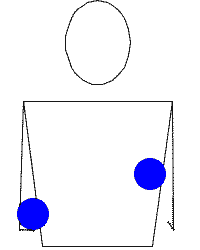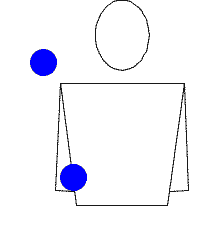Juggling. Theory. Practice
Wary of non-profile topics, but decided to write this one for the following reasons:
To say that juggling is a sequence of throws is the same as saying that music is just a sequence of notes. This cannot be called untruth, but anyone, at least a little familiar with musical theory, will be indignant at the last definition - so superficial and not far.
Take a look at 3 tricks (there are a lot of them in general) with 3 items (about the numbers in brackets just below)
Cascade ("3")

Circle ("51")
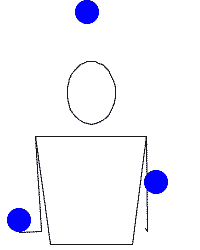
')
531 ("531")
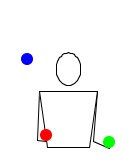
They have regularities:
It should be noted that in other tricks any of these items may be incorrect. However, to understand the essence there is no need to delve into the subtleties.
After considering the patterns, the following questions appear:
Juggler notation was invented for this. Each trick is described by a pattern called SiteSwaps. He does not give a complete description, but sets the base of the trick. The first animation shows a trick with sitetouch "3", on the 2nd - "51", on the 3rd - "531". We write them like this:
Clear? We looped the site-swap and under each digit indicated the hand that throws the ball. Each number is some kind of a throw. For a quicker understanding, we can say that they mean the height at which the ball is thrown. But this is only a consequence. Time is broken into bars. Every beat is made a throw. On even measures, one hand works, on odd other. If the hand (for example, the right hand) makes a throw 3, then this ball will be free again only after 3 bars. All this time we do not need to think about it. But we still have balls! After the first measure, our left hand must be activated first, then, after the second, the right hand. And finally, after the third tact, our ball will return, and we must throw it away with our left hand.
As you might guess, all the balls with odd throws should be caught with the other hand, and even with the same one that was thrown. And the bigger the number, the higher the ball should fly.
More visual scheme:
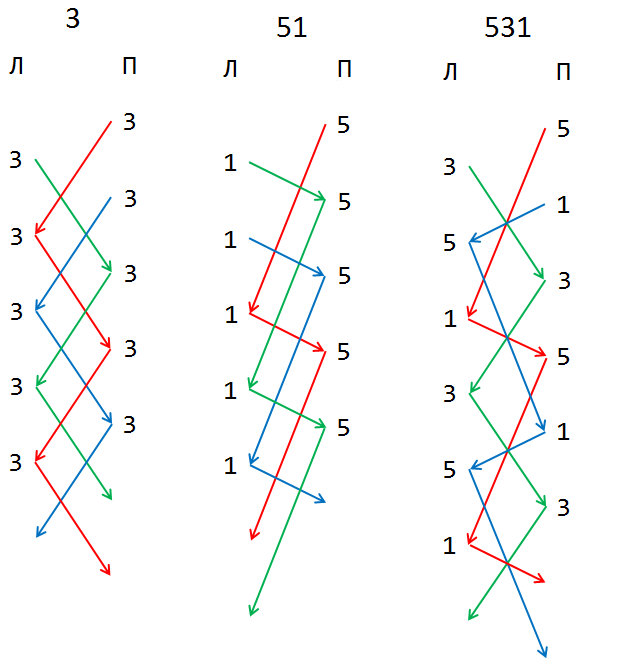
A throw of “0” in a site svape, is not a throw, as this is a designation that there is no ball in hand. “1” is a quick horizontal throw from one hand to the other. “2” - formally, this is a small toss in the hand, but in practice, the ball is not thrown away, but simply held in the hand.
The average value of all digits of a website is equal to the number of balls.
On the simulator (java), you can see how the trick will look like if you know saytosvop.
Saytsvop sets only a certain pattern. On the basis of one saystvopa you can come up with many tricks, changing throws and hand movements.
Imagine that we have learned to make a cascade ("3") and a circle ("51"). Of course, this must be shown to all friends and acquaintances! But take your time. If you show one trick first, stop, then show the second, it will not be very impressive compared to a smooth, almost imperceptible transition right in the air, without stopping the juggling. This is where the notation will help you.
It is logical that the transition will look something like this: ... 333xx5151 ... X is an unknown throw. Why are they 2? With one is too simple and obvious, with three the example will be unnecessarily complicated (then try it yourself). Let's make it clearer, noting by the arrows all the throws that we know:
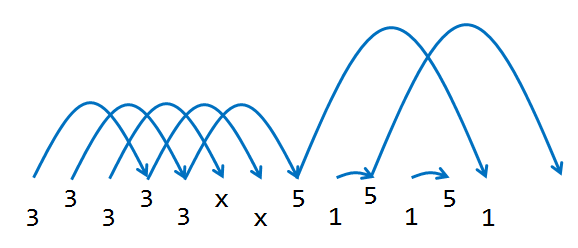
It is necessary to connect the arrows X with (specifically in this case) units. This can be done in two ways:


Check in the simulator what happened (I added the transition from "51" to "3" again: 515123333, since the site-swap is performed cyclically and should not be broken):
1st transition:
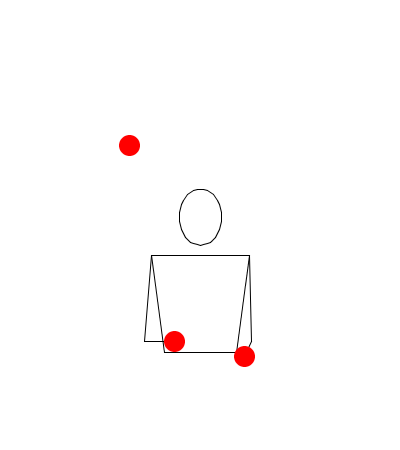
2nd transition:

Why I recommend to juggle in spare time? Because juggling:
I like the introduction on jugglers.ru:
Let's get started You will need three items of spherical shape. To begin with, apples, tangerines,chicken eggs , potatoes will do. For a long time they will not be enough, but for the test will come down. If you like it, it is better to fill the tennis ball with grain or water (syringe) and seal the hole. It is even better to fill the old sock with peas, sew and fit it with an air ball.
In short, the fastest teaching method looks like this (for reference only! For a serious study, follow the link below).
Interested? Then you here: www.jugglers.ru/content/view/13/31
Duration of training is very different. Someone claims to have learned in half an hour, someone in a month. And it is not clear what is meant by the ability to juggle? I dare to suggest: on average, it takes several hours to make 10-20 shots, for sure juggling a few dozen hours.
And this is just one more trick. And a lot of them. You can learn them using jugglers.ru . This is not advertising, but the only Russian site dedicated to juggling.
UPD. Shens :
- Juggling has its own theory - slim and mathematically attractive!
- We live not only work. Juggling - great fun and warm up after a long sitting at the computer.
- On Friday, it's nice to relax a bit and read not very serious articles. In addition, there will be something to do on the weekend, especially if you did not have certain plans.
Theory
To say that juggling is a sequence of throws is the same as saying that music is just a sequence of notes. This cannot be called untruth, but anyone, at least a little familiar with musical theory, will be indignant at the last definition - so superficial and not far.
Take a look at 3 tricks (there are a lot of them in general) with 3 items (about the numbers in brackets just below)
Cascade ("3")

Circle ("51")

')
531 ("531")

They have regularities:
- Hands work alternately - right, left, right, left ...
- Having received the ball, the hand immediately throws it along a certain trajectory.
- Each hand at each time operates with a maximum of one ball. Thus, despite different trajectories and different flight times (especially clearly seen in the last figure), the balls never conflict with each other.
It should be noted that in other tricks any of these items may be incorrect. However, to understand the essence there is no need to delve into the subtleties.
After considering the patterns, the following questions appear:
- How to describe tricks?
- How to display new?
- How to smoothly move from one trick to another?
Juggler notation was invented for this. Each trick is described by a pattern called SiteSwaps. He does not give a complete description, but sets the base of the trick. The first animation shows a trick with sitetouch "3", on the 2nd - "51", on the 3rd - "531". We write them like this:
() -> «3» : 3 3 3 3 3 3 3 3 3 3 3 3 ... «51» : 5 1 5 1 5 1 5 1 5 1 5 1 ... «531» : 5 3 1 5 3 1 5 3 1 5 3 1 ... ... Clear? We looped the site-swap and under each digit indicated the hand that throws the ball. Each number is some kind of a throw. For a quicker understanding, we can say that they mean the height at which the ball is thrown. But this is only a consequence. Time is broken into bars. Every beat is made a throw. On even measures, one hand works, on odd other. If the hand (for example, the right hand) makes a throw 3, then this ball will be free again only after 3 bars. All this time we do not need to think about it. But we still have balls! After the first measure, our left hand must be activated first, then, after the second, the right hand. And finally, after the third tact, our ball will return, and we must throw it away with our left hand.
As you might guess, all the balls with odd throws should be caught with the other hand, and even with the same one that was thrown. And the bigger the number, the higher the ball should fly.
More visual scheme:

A throw of “0” in a site svape, is not a throw, as this is a designation that there is no ball in hand. “1” is a quick horizontal throw from one hand to the other. “2” - formally, this is a small toss in the hand, but in practice, the ball is not thrown away, but simply held in the hand.
The average value of all digits of a website is equal to the number of balls.
On the simulator (java), you can see how the trick will look like if you know saytosvop.
Saytsvop sets only a certain pattern. On the basis of one saystvopa you can come up with many tricks, changing throws and hand movements.
Some tricks with sitezvopom "3"
Although they look very different, the essence is the same - all are three-stroke throws and each ball flies from one hand to the other.
Tennis

Spiral
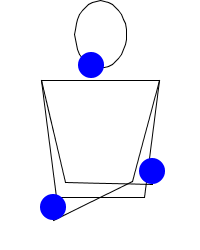
Mills mass
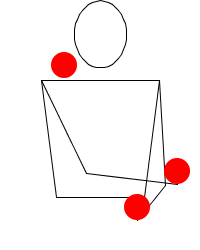
Boston mess
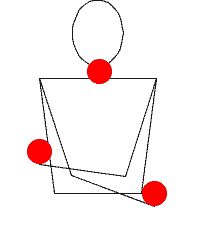
Tennis

Spiral

Mills mass

Boston mess

Transitions
Imagine that we have learned to make a cascade ("3") and a circle ("51"). Of course, this must be shown to all friends and acquaintances! But take your time. If you show one trick first, stop, then show the second, it will not be very impressive compared to a smooth, almost imperceptible transition right in the air, without stopping the juggling. This is where the notation will help you.
It is logical that the transition will look something like this: ... 333xx5151 ... X is an unknown throw. Why are they 2? With one is too simple and obvious, with three the example will be unnecessarily complicated (then try it yourself). Let's make it clearer, noting by the arrows all the throws that we know:

It is necessary to connect the arrows X with (specifically in this case) units. This can be done in two ways:


Check in the simulator what happened (I added the transition from "51" to "3" again: 515123333, since the site-swap is performed cyclically and should not be broken):
1st transition:

2nd transition:

Practice
Motivation
Why I recommend to juggle in spare time? Because juggling:
- Improves the interaction between the hemispheres of the brain. According to the theory, programmers mostly have the left hemisphere loaded, so let's use the right one too.
- It gives a great mood and feeling of flight when a new trick is obtained.
- Relieves stress.
- Develops dexterity and endurance hands.
- He straightens his posture, as it is more difficult to juggle with slouching, and the back straightens by itself so that it is more convenient for the eyes to follow the balls.
- Flow condition
- And this is just a great pastime!
We try
I like the introduction on jugglers.ru:
To begin, please remember that if you can do this:
never say you can juggle with two balls. This is not juggling. To say that you juggle with two balls, you can only after doing this:
or at least like this:
Let's get started You will need three items of spherical shape. To begin with, apples, tangerines,
In short, the fastest teaching method looks like this (for reference only! For a serious study, follow the link below).
- Take the subject in hand. Transfer it to your other hand. Flight altitude - approximately at the level of your height. And back. Once again. Repeat until you get bored.
- Exchange of two items: now take in each hand on the subject. In a well-trained movement of point 1, drop one item. When he is at his highest point, drop another item. It remains to catch first the first, then the second. Practice your first throw with one hand, then the other.
- Exchange of three items. Now you have two items in one hand, two in the other. Start as in point 2, just add the third shot when the second ball is at the highest point.
- If you got point 3, try adding a 4th roll, then a 5th roll, and so on.
Interested? Then you here: www.jugglers.ru/content/view/13/31
Duration of training is very different. Someone claims to have learned in half an hour, someone in a month. And it is not clear what is meant by the ability to juggle? I dare to suggest: on average, it takes several hours to make 10-20 shots, for sure juggling a few dozen hours.
And this is just one more trick. And a lot of them. You can learn them using jugglers.ru . This is not advertising, but the only Russian site dedicated to juggling.
UPD. Shens :
Caution! Juggling is contagious! Having learned how to make an ordinary cascade, I want to learn more and more interesting tricks.
The article is beautiful, there are not enough references for motivational funny videos like www.youtube.com/watch?v=q37vo62psGA =)
Source: https://habr.com/ru/post/148940/
All Articles
